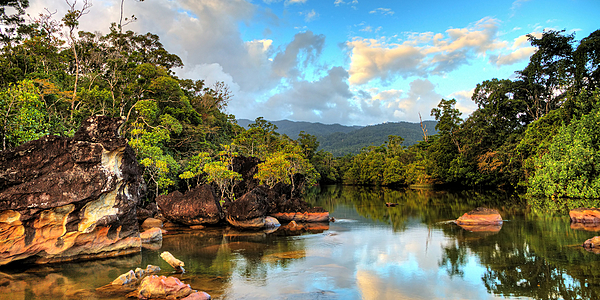


The Malagasy people of the Highlands are known to be a people of walkers, so it seemed obvious to me that the best way to meet and understand them would be a good trek. Walk far from the cities and agitation, let yourself wander in the footsteps of these farmers, these people who live by the sweat of their brows and who reap the fruit of their labour with courage and dignity.
From Ambositra, we take the RN7 in the direction of Antoetra and discover the Highlands . A real rice bowl, this region comforts us in the thought that all the day’s efforts will be rewarded and even honoured with the chance to taste of one of the most widely-exported varieties of rice in the world.
Here, rice farming sets the pace for the day-to-day life of the whole population. Even more aesthetic than a work of "land-art", these rice fields offer a kaleidoscope of greens in the perfectly carved terraces that encircle the villages built on the hillsides. It offers the perfect picture postcard of a sumptuous and generous landscape that has been sculpted with perfection by the hand of man, and which gives you the impression of stepping into a painting by a grand master of impressionism.
We then leave the road at Ivato and our dirt track takes us away from the mountain ridges to plunge little by little into the forest, where we encounter the first villages built in wood: welcome to the mysterious world of the Zafimaniry civilization, for a total immersion in a true artistic culture!
A sub-group of the Betsileo, the Zafimaniry tribe, with a population of a few tens of thousands of people, is concentrated along the edge of the forest to the east of Antoetra. The locals derive all their resources from the surrounding forest (wood for construction, heating or carving, medicinal plants and game, consisting mainly of wild boar).
It is an authentic museum of craftsmanship - whose know-how and skills were rewarded by Unesco in 2006. A visit to the village of Tetezandrotra will bring us into contact with the precursors of the technique of assembly without nails. On the walls of these finely-carved traditional wooden houses, geometric designs symbolise the family status within an ethnic group: family ties (the tanamparoratra = spider's webs), or community life (papintantely = the honeycomb).

As in all the remote villages, traditions and beliefs persist and it is advisable to respect the customs of our hosts for the evening... I challenge anyone who would dare refuse our local team's round of rum to venture alone on the forest trails once night falls and they are drenched in darkness!
Around the campfire that we share with the villagers, the joyful and animated chatter dwindles little by little into the dark night of this deep and mysterious forest.
In the morning, the trek continues in this forest environment imbued with culture and mysticism. We move ahead as if we were on a treasure hunt, searching for new clues and real evidence of the existence of the traditions that are perpetuated here, in Zafimaniry country.
The perfect proof that Malagasy culture is still alive and well is offered by these stone steles( the tsangambato also called tatao) that have been erected along the trails in tribute to the ancestors. The custom requires that, as a sign of respect to the ancestors, visitors must leave an offering (a little honey, a coin or even some local rum - toaka gasy) - ) at the foot of these "standing stones".
What an honour to set foot on these lands steeped in history and beliefs, and to discover these works sculpted by the hands of masters deep in the heart of this captivating natural environment!
For the success of this trek that is guaranteed to be off the beaten path, it is not enough to speak Malagasy perfectly or to have an excellent sense of direction in the rice paddies! In all, the tour lasts 3 days, with an average of 3 to 6 hours of walking per day. We take the RN7 from Ambositra and leave it at Ivato to reach Antoetra after a journey of nearly 26 kilometres along a dirt track. At Sakaivo, Tetezandrotra or Ifaliarivo, the effort is quickly rewarded by the numerous contacts in the villages that we go through. It is a real discovery of the rural world of the Highlands and certainly does not lack interest!